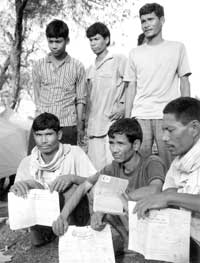 Things are looking up in Srilanka. Not Ceylon. But Srilanka in Nepal's Kailali District, the former kamaiya rehabilitation camp. It looks like a new planned township, houses with tin roofs in neat rows on either sides of dusty alleys. Other houses are going up in empty plots, sweaty workers are making dhikaries traditional mud containers to store food grains.
Things are looking up in Srilanka. Not Ceylon. But Srilanka in Nepal's Kailali District, the former kamaiya rehabilitation camp. It looks like a new planned township, houses with tin roofs in neat rows on either sides of dusty alleys. Other houses are going up in empty plots, sweaty workers are making dhikaries traditional mud containers to store food grains.
Chet Ram Chaudhary of Srilanka camp already has plenty to fill up his dhikaries. He was able to harvest more than five quintals of paddy last season in his land, and hopes that with complementing income from odd labour jobs, the grain will sustain his small family of three for the coming year. "I have enough to feed my family for present therefore, I afford to give my time for social works," he said with the pride that he is a member of the school and sanitation and drinking water development committees in his neighbourhood.
The Srilanka camp is a success story in an ocean of despair among freed kamaiyas in Nepal's southwestern plains. The Srilankans are the lucky ones who got parcels of land registered in their names. They got timber and tin to construct their homes from the government and charity groups. Others are not so lucky-they are still languishing in makeshift camps living in shacks with plastic roofs on unregistered government land and in constant fear of sudden eviction.  "We are free, but our lives are not much better than what we used to have before leaving the kisan household," Ragahi Chaudhary told us from inside his hut at Bangai Phata in Bardiya. Last year the District Forest Office in Bardiya set fire to kamaiya huts to expel squatters. Since these former bonded labourers have no place to go, they just moved down the road to another plot at the edge of the jungle. Ragahi Chaudhary and 133 other families live in constant fear of another eviction.
"We are free, but our lives are not much better than what we used to have before leaving the kisan household," Ragahi Chaudhary told us from inside his hut at Bangai Phata in Bardiya. Last year the District Forest Office in Bardiya set fire to kamaiya huts to expel squatters. Since these former bonded labourers have no place to go, they just moved down the road to another plot at the edge of the jungle. Ragahi Chaudhary and 133 other families live in constant fear of another eviction.
On 17 July 2000, the government outlawed the kamaiya system, a perpetual bonded labour system, practiced mostly in five far-western tarai districts of Banke, Bardiya, Kailali, Kanchanpur and Dang. The government announcement immediately and automatically ended all the debt and labour obligations of kamaiyas who left their employers (kisans).
Presently, former kamaiyas are living in 65 camps. Last year, the government distributed identity cards to former kamaiyas-red cards for kamaiyas without any landholding and blue for those owning some land. The government distributes rehabilitation support, including distribution of housing plots, on the basis of these identity cards. Official records show that more than 18,000 households have identity cards, of which 80 percent have already been distributed land for settlement.
However, the non-governmental organisations involved in rehabilitation are not happy with the identification card system. The Backward Society Education (BASE), an NGO spearheading kamaiya rights says 2,600 households of ex-Kamaiyas are left out of the identification process. BASE director Dilli Bahadur Chaudhary told us the lack of government coordination is the reason for the problem.
The process requires kisans to endorse kamaiyas before they can qualify for the identity cards. Many kisan refused to identify their former kamaiyas fearing compensation payments for bondage.
"It's just a stunt," says Sindari Devi Chaudhary of Manahara in Kailali. "We are toys in the hands of a hypocrite government that lacks sincerity."
 Under secretary at the Ministry of Land Reform and Management Shankar Prasad Dhungana is aware that many ex-kamaiyas missed out in the list, and assures them his office will make amends. "We need a cabinet decision to make it happen, but it is responsibility of the ex-kamaiyas to make their voice heard at the policymaking level," he said at a kamaiya conference in Nepalgunj this weekend.
Under secretary at the Ministry of Land Reform and Management Shankar Prasad Dhungana is aware that many ex-kamaiyas missed out in the list, and assures them his office will make amends. "We need a cabinet decision to make it happen, but it is responsibility of the ex-kamaiyas to make their voice heard at the policymaking level," he said at a kamaiya conference in Nepalgunj this weekend.
The main problem is that government departments don't coordinate their activities. In Kailali, for example, the Land Reform Office identified the areas for kamaiya settlement, but the District Forest Office refused to allow it.
In Banke some kamaiya families were distributed land ownership certificates without having a land to own. We met Budhi Ram Tharu and 27 other households who were distributed land ownership certificates four months back that shows each family holds 5 katthas of land in Manau village. The Banke District Forest Office refused them the promised plots in Manau. Now the Land Distribution Committee has promised them 3 katthas of land in Machhagadh village where they are staying in plastic tents since last two weeks.
Ramdev Chaudhary, leader of recently formed Liberated Kamaiyas Upliftment Committee, draws only one conclusion: "The government just wants to weaken our collective movement. But we are determined to fight for our right. We'll keep struggling."


